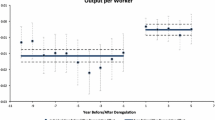Abstract
Based on panel data of 64 countries during 1984–2012, this paper applies multi-threshold model to empirically verify the threshold effects of capital account liberalization on country’s aggregate productivity. Bootstrap test result shows: capital account liberalizations of the countries at different development level have heterogeneous influences on the total factor productivity, namely, “threshold effect” exists; furthermore, financial development and per capita GDP of a country decide the direction and intensity of capital account liberalization influencing the total factor productivity to a large extent; finally, productivity growth effect of capital account liberalization has a non-monotonic relation with the financial development. As far as the developing countries at middle income-level are concerned, after their financial development has reached a certain level, finance liberalization can effectively facilitate the growth of total factor productivity.
Similar content being viewed by others
Notes
Such as the financial crisis in Mexico in 1994, the southeast Asian financial crisis in 1997, the Russian financial crisis in 1999, Argentina crisis in 2001, and so on.
Sample data covers the main developed and emerging marketing economies as many as possible in the world and period of intensive implementation of capital account liberalization policies.
It is worth noting that we control the institutional quality for that capital account liberalization will create the positive influence on productivity by facilitating domestic institutional quality and corporate governance [8].
References
Kose, M., Prasad, E., & Terrones, M. (2009). Does openness to international flows raise productivity growth? Journal of International Money and Finance, 28(4), 554–580.
Hall, R. E., & Charles, I. J. (1999). Why do some countries produce so much more output per worker than others? Quarterly Journal of Economics, 114(1), 83–116.
Bekaert, G., Harvey, C. R., & Lundblad, C. (2011). Financial openness and productivity. World Development, 39(1), 1–19.
Bonfiglioli, A. (2008). Financial integration, productivity and capital accumulation. Journal of International Economics, 76(2), 337–355.
Demirgüç-Kunt, A., & Detragiache, E. (2002). Does deposit insurance increase banking system stability? An empirical investigation. Journal of Monetary Economics, 49(7), 1373–1406.
Ding, D., & Jinjarak, Y. (2012). Development threshold, capital flows, and financial turbulence. The North American Journal of Economics and Finance, 23(3), 365–385.
Kose, M., Prasad, E., & Taylor, A. D. (2011). Thresholds in the process of international financial integration. Journal of International Money and Finance, 30(1), 147–179.
Eichengreen, B., Gullapalli, R., & Panizza, U. (2011). Capital account liberalization, financial development and industry growth: A synthetic view. Journal of International Money and Finance, 30(6), 1090–1106.
Kaya, I., Lyubimov, K., & Miletkov, M. (2012). To liberalize or not to liberalize: Political and economic determinants of financial liberalization. Emerging Markets Review, 13(1), 78–99.
Kitano, S. (2011). Capital controls and welfare. Journal of Macroeconomics, 33(4), 700–710.
Larrain, M., & Stumpner, S. (2017). Capital account liberalization and aggregate productivity: The role of firm capital allocation. The Journal of Finance, 72(4), 1825–1858.
Hansen, B. E. (1999). Threshold effects in non-dynamic panels: estimation, testing, and inference. Journal of Econometrics, 93(2), 345–368.
Chinn, M., & Ito, H. (2006). What matters for financial development? Capital controls, institutions and interactions. Journal of Development Economics, 8(1), 163–192.
Acknowledgements
The authors acknowledge National Social Science Foundation of China (Grant: 15ZDC020); the National Natural Science Foundation of China (Grant: 71373187); National Social Science Foundation of China (Grant: 15BJY172).
Author information
Authors and Affiliations
Corresponding author
Rights and permissions
About this article
Cite this article
Jiang, C., Zhang, P. Threshold Effects of Capital Account Liberalization on Productivity: Bootstrap Method in Non-dynamic Panels. Wireless Pers Commun 102, 713–723 (2018). https://doi.org/10.1007/s11277-017-5088-0
Published:
Issue Date:
DOI: https://doi.org/10.1007/s11277-017-5088-0




